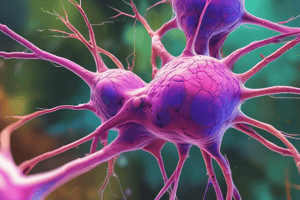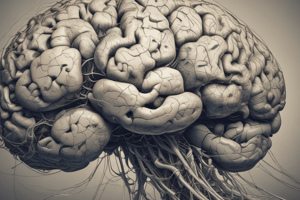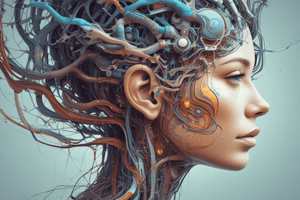Podcast
Questions and Answers
What structure did the early vertebrate 'brain' begin as?
What structure did the early vertebrate 'brain' begin as?
- A neural network
- A series of bulges
- A simple tube (correct)
- A cerebral hemisphere
The anterior commissure is a group of nerve tracts connecting a series of regions in the brain.
The anterior commissure is a group of nerve tracts connecting a series of regions in the brain.
False (B)
What does the visual cortex send signals back to for further integration?
What does the visual cortex send signals back to for further integration?
thalamus
The cortex is organized into a stack of distinct _______ that span its thickness.
The cortex is organized into a stack of distinct _______ that span its thickness.
Match the brain components with their correct description:
Match the brain components with their correct description:
What is the result of the visual cortex sending signals back to the thalamus?
What is the result of the visual cortex sending signals back to the thalamus?
The layers in the cortex are arranged in horizontal columns.
The layers in the cortex are arranged in horizontal columns.
What happened in early vertebrates as neurons were added to the nerve cord?
What happened in early vertebrates as neurons were added to the nerve cord?
What is the primary function of the visual cortex?
What is the primary function of the visual cortex?
Reflex loops involve the cerebral cortex before eliciting action.
Reflex loops involve the cerebral cortex before eliciting action.
What is the range of frequencies for beta waves?
What is the range of frequencies for beta waves?
In early mammals, cortical tissues in the cerebrum and the _________ were developed.
In early mammals, cortical tissues in the cerebrum and the _________ were developed.
Match the brain area and its function:
Match the brain area and its function:
What is the typical ratio of excitatory to inhibitory neurons in most brain areas?
What is the typical ratio of excitatory to inhibitory neurons in most brain areas?
The strength of signals from neighboring circuits cannot shift a neuron's response dynamically
The strength of signals from neighboring circuits cannot shift a neuron's response dynamically
What brain regions produce beta waves?
What brain regions produce beta waves?
What is the defining characteristic of a pyramidal cell?
What is the defining characteristic of a pyramidal cell?
Pyramidal cells have one set of dendrites.
Pyramidal cells have one set of dendrites.
What is the function of neuroglia?
What is the function of neuroglia?
The main 'immune cells' of the brain are the ______.
The main 'immune cells' of the brain are the ______.
Match the following terms related to the passage:
Match the following terms related to the passage:
What causes calcium ions to flow into the cell during neurotransmission?
What causes calcium ions to flow into the cell during neurotransmission?
Neurotransmitters are released from the dendrites.
Neurotransmitters are released from the dendrites.
Which of the following best describes the function of dendrites?
Which of the following best describes the function of dendrites?
Excitatory neurons typically loop their responses back to earlier segments of a circuit.
Excitatory neurons typically loop their responses back to earlier segments of a circuit.
What happens when calcium ions bind to the synaptic vesicles?
What happens when calcium ions bind to the synaptic vesicles?
What are the chemical messengers released by axon terminals called?
What are the chemical messengers released by axon terminals called?
The fatty sheath surrounding some axons is called ______.
The fatty sheath surrounding some axons is called ______.
Match the following neuron components with their functions:
Match the following neuron components with their functions:
What is the role of oligodendrocytes in the nervous system?
What is the role of oligodendrocytes in the nervous system?
Ion channels are responsible for transporting neurotransmitters across the neuronal membrane.
Ion channels are responsible for transporting neurotransmitters across the neuronal membrane.
What is the name of the junctions where neurons communicate?
What is the name of the junctions where neurons communicate?
Where are hair cells positioned?
Where are hair cells positioned?
Each hair cell responds equally to all sound frequencies.
Each hair cell responds equally to all sound frequencies.
What affects the range of sound frequencies a hair cell responds to?
What affects the range of sound frequencies a hair cell responds to?
Taste depends on molecules set free when we ______.
Taste depends on molecules set free when we ______.
Match the following structures with their function:
Match the following structures with their function:
Where are the sensory neurons for smell located?
Where are the sensory neurons for smell located?
The taste sense can distinguish a wide spectrum of flavors.
The taste sense can distinguish a wide spectrum of flavors.
What structure do the axons of sensory neurons pass through before entering the olfactory bulbs?
What structure do the axons of sensory neurons pass through before entering the olfactory bulbs?
Which of the following taste qualities is NOT one of the five basic tastes?
Which of the following taste qualities is NOT one of the five basic tastes?
The brainstem and thalamus use information from both ears to compute a sound’s direction and location.
The brainstem and thalamus use information from both ears to compute a sound’s direction and location.
What are the sensory cells that are receptive to smells called?
What are the sensory cells that are receptive to smells called?
The tips of olfactory cells are equipped with several hair-like ______ that are receptive to different odors.
The tips of olfactory cells are equipped with several hair-like ______ that are receptive to different odors.
Which combination of tastes is mentioned in relation to enhancing sweetness?
Which combination of tastes is mentioned in relation to enhancing sweetness?
Match the following concepts with their correct descriptions:
Match the following concepts with their correct descriptions:
All tastes are detected across the tongue.
All tastes are detected across the tongue.
Name one way the combination of tastes can influence perception, as mentioned.
Name one way the combination of tastes can influence perception, as mentioned.
Flashcards
Neural Network
Neural Network
A group of interconnected nerve cells that work together to perform specific functions in the brain.
Corpus Callosum
Corpus Callosum
A structure in the brain that transmits signals between the left and right hemispheres, enabling coordination between the two sides.
Anterior Commissure
Anterior Commissure
A smaller structure in the brain that transmits signals between the left and right temporal lobes.
Cerebral Cortex
Cerebral Cortex
Signup and view all the flashcards
Brain Waves
Brain Waves
Signup and view all the flashcards
Cortical Column
Cortical Column
Signup and view all the flashcards
Neural Pathways
Neural Pathways
Signup and view all the flashcards
Sensory Integration
Sensory Integration
Signup and view all the flashcards
Excitatory neurons
Excitatory neurons
Signup and view all the flashcards
Inhibitory neurons
Inhibitory neurons
Signup and view all the flashcards
Excitatory-Inhibitory Balance
Excitatory-Inhibitory Balance
Signup and view all the flashcards
Hyperpolarization
Hyperpolarization
Signup and view all the flashcards
Beta Waves
Beta Waves
Signup and view all the flashcards
Synaptic Plasticity
Synaptic Plasticity
Signup and view all the flashcards
Visual Cortex
Visual Cortex
Signup and view all the flashcards
Reflex Loop
Reflex Loop
Signup and view all the flashcards
Neurons
Neurons
Signup and view all the flashcards
Axon
Axon
Signup and view all the flashcards
Synapse
Synapse
Signup and view all the flashcards
Neurotransmitters
Neurotransmitters
Signup and view all the flashcards
Soma
Soma
Signup and view all the flashcards
Dendrites
Dendrites
Signup and view all the flashcards
Neurotransmission
Neurotransmission
Signup and view all the flashcards
Astrocytes
Astrocytes
Signup and view all the flashcards
Cell body
Cell body
Signup and view all the flashcards
Axon terminals
Axon terminals
Signup and view all the flashcards
Feedback inhibition
Feedback inhibition
Signup and view all the flashcards
Sound localization
Sound localization
Signup and view all the flashcards
Auditory pathway
Auditory pathway
Signup and view all the flashcards
Brainstem and thalamus in sound localization
Brainstem and thalamus in sound localization
Signup and view all the flashcards
Basic taste qualities
Basic taste qualities
Signup and view all the flashcards
Umami
Umami
Signup and view all the flashcards
Olfactory sensitivity
Olfactory sensitivity
Signup and view all the flashcards
Taste and smell interaction
Taste and smell interaction
Signup and view all the flashcards
Olfactory cilia
Olfactory cilia
Signup and view all the flashcards
Hair Cells in Cochlea
Hair Cells in Cochlea
Signup and view all the flashcards
Basilar Membrane
Basilar Membrane
Signup and view all the flashcards
Sound Frequency Detection
Sound Frequency Detection
Signup and view all the flashcards
Olfactory Sensory Neurons
Olfactory Sensory Neurons
Signup and view all the flashcards
Olfactory Bulbs
Olfactory Bulbs
Signup and view all the flashcards
Taste and Molecules
Taste and Molecules
Signup and view all the flashcards
Basic Tastes
Basic Tastes
Signup and view all the flashcards
Taste vs. Smell in Flavor
Taste vs. Smell in Flavor
Signup and view all the flashcards
Study Notes
Brain Basics
- The brain is the nerve center of the body, containing billions of neurons that transmit information and program responses.
- The brain can perform multiple tasks simultaneously thanks to specialized regions for specific tasks and abilities.
- The cerebrum is the largest part of the brain, divided into two hemispheres connected by the corpus callosum.
- Each hemisphere contains lobes: frontal (coordinating voluntary movements and higher cognitive skills), parietal (integrating sensory signals), occipital (processing visual information), and temporal (visual and auditory processing).
- The hippocampus (memory encoding) and amygdala (integrating memory and emotion) are part of the limbic system which regulates emotions and motivation.
- The thalamus integrates sensory information and relays it to other brain parts, while the hypothalamus controls hormonal signals through the pituitary gland.
- The midbrain coordinates eye movements, reflexes, and fine motor control; the hindbrain plays a role in movement, glucose regulation, sleep, and posture.
Brain Evolution
- The complex human brain evolved from a simple tube-like structure in early vertebrates.
- Early vertebrate brains had specialized regions for processing sensory and motor information.
- As vertebrates evolved, processing expanded in sensory and motor areas; the olfactory bulbs and visual regions expanded.
- The cerebellum expanded to control movement and spatial orientation, which became more important with increased vertebrate activity.
- In early mammals, the cerebrum and cerebellum expanded even further, increasing processing power through layers and folds.
Neural Networks and Circuits
- Information travels between brain regions through chains of neurons called nerve tracts (e.g., corpus callosum).
- Neural networks route signals through the brain for analysis and organization.
- Neural circuits interconnect neurons; they transform input signals into output patterns to encode complex information.
- Neurons are organized in distinct layers that span the thickness of the cortex (like shelves in a bookcase).
- Each column in the cortex is dedicated to a specific processing task, but neighboring circuits influence neural activity.
Excitatory and Inhibitory Neurons
- Neurons are either excitatory or inhibitory.
- Most brain neurons (about 80%) are excitatory, pushing neighbors towards firing (e.g., pyramidal cells).
- Inhibitory neurons (about 20%) suppress the activity of neighboring neurons and regulate circuit activity.
- Neuronal organization in circuits is crucial for learning and refining signals to the body and other brain parts.
Neurons and Glia
- Neurons transmit electrical signals between nerve cells, muscles, or glands; they consist of a cell body, dendrites, and an axon.
- Glial cells (astrocytes, microglia, ependymal cells, and oligodendrocytes) support and regulate neuronal function.
- Ion channels allow ions to cross a neuron's membrane, changing the voltage across the membrane.
- Synapses are the junctions between neurons where neurotransmitters (chemical signals) are released.
Receptors and Molecular Signaling
- Neurotransmitters fit into specific receptors on postsynaptic membranes; they are either ionotropic or metabotropic.
- Receptors and channels can be modified by hormones, neuromodulators (e.g., endocannabinoids), and prostaglandins (affecting pain sensitivity).
- Some molecules diffuse through cell membranes (e.g., steroids); their receptors are inside the soma.
- Genes, gene expression, and changes in chromatin influence neuron function and structure.
- Genetic variants or alleles affect protein function and can cause neurological conditions (e.g., Tay-Sachs disease).
Senses and Perception
- Sensory organs translate energy and molecules into electrical signals (transduction).
- The visual system, involving 30% of the cerebral cortex, translates light into electrical signals.
- The retina's photoreceptors (rods and cones) convert light into electrical signals.
- Rods detect low light; cones detect fine detail and color.
- Input from two eyes enables depth perception, and the retina preserves visual information.
- The brain processes visual information in parallel streams for object recognition and spatial location.
Senses and Perception (Continued): Hearing
- The auditory system processes sound waves; converting them into electrical signals via hair cells.
- The basilar membrane vibrates to different frequencies (pitches) along the cochlea.
- Hair cells convert physical movement to electrical signals, which travel to the auditory cortex via the auditory nerve.
Senses and Perception (Continued): Taste and Smell
- Taste and smell receptors are exposed to the outside environment and vulnerable to damage.
- Taste receptors (taste buds) detect sweet, sour, salty, bitter, and umami (savory) tastes.
- Smell receptors in the nasal cavity detect odor molecules and send signals directly to the olfactory cortex.
- Taste and smell information converge to create the perception of flavor.
Touch and Pain
- The somatosensory system detects touch, pressure, vibration, temperature, texture, itch, and pain.
- Touch receptors are located in different skin layers.
- Pain is a sensory and emotional experience; warning of potential damage.
- Nociceptors respond to stimuli that cause tissue damage.
- Pain messages travel up the spinal cord through the brainstem and thalamus to the somatosensory cortex.
- Pain management can involve the brain's periaqueductal gray matter and the release of endorphins.
Movement
- The central nervous system (brain and spinal cord) controls coordinated muscle actions for movement.
- Muscles attach to the skeleton at joints.
- Flexors and extensors work in opposition.
- Motor units consist of alpha motor neurons and associated muscle fibers.
- Reflexes are involuntary, automatic muscle responses to stimuli.
- Specialized receptors in the muscles and tendons provide feedback to the brain, guiding the movement.
Learning, Memory, and Emotions
- The medial temporal lobe (hippocampus and parahippocampal regions) converts memories to long-term declarative memory.
- Declarative memories include semantic (general knowledge) and episodic (personal experiences).
- Nondeclarative memory governs learned motor skills.
- Memory formation involves synaptic plasticity, characterized by structural changes at synapses (LTP/LTD).
- The amygdala is a key region for processing emotions, especially fear and emotional associations with rewards.
Thinking, Planning, and Language
- The brain filters information, interprets perceptions, and builds representations.
- Semantic memory plays a role in interpreting perceptions by linking them to past experiences.
- Specific cortical networks process different categories of information.
- "Concept cells” work together to form semantic representations of objects, actions, and social information.
- Damage to parts of the temporal lobes affects object recognition.
Infant, Child, and Adolescent Brain
- The infant brain continues rapid development after birth (1% daily increase initially).
- Synaptic pruning allows weaker connections to weaken while stronger connections grow and solidify.
- The brain is highly plastic, adapting to experiences throughout life.
- Adolescence is marked by further maturation in the frontal lobes, increasing cognitive control abilities.
Adult and Aging Brain
- The adult brain continues to develop and change throughout life, showing a decline in some areas like gray matter density and white matter growth.
- Cognitive functions like memory, attention, and problem-solving sometimes decline with age.
- The prefrontal cortex's maturation is associated with increased cognitive control, delaying emotional and impulsive responses.
- The aging brain undergoes changes in various brain areas, including neuronal structures and chemical composition.
Psychiatric Disorders
- Psychiatric disorders arise from a mix of genetic and environmental factors.
- Anxiety disorders, PTSD, OCD, and panic attacks are common.
- Mood disorders (depression, bipolar disorder) also have varied causes.
- Genetic and brain imaging studies provide insights into the biological underpinnings of mental disorders.
Addiction
- Addiction is a chronic brain disease marked by loss of control over substance use.
- Factors like tolerance and withdrawal contribute to the addiction cycle.
- The brain's reward system is highly influenced by addictive substances such as nicotine, opioids and alcohol.
- Nicotine replacement therapy, nonnicotine medications, and behavioral therapies can treat nicotine addiction.
- The brain is changed by drug abuse resulting in physical and psychological dependence.
Studying That Suits You
Use AI to generate personalized quizzes and flashcards to suit your learning preferences.



